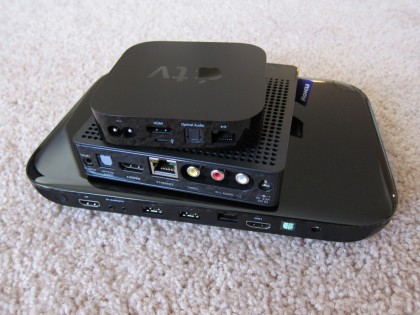
All Around
Our second annual ‘boxes of the year’ column doesn’t dramatically differ from the 2009 edition. Which is somewhat surprising given how quickly the tech sector iterates and innovates. And my favorite all around box is still the Xbox 360 ($199). It’s been redesigned for 2010 with a sleeker, home theater-friendly form and color (black) that hopefully contains more reliable and intelligently designed hardware. ESPN3 is also new for ’10, rounding out a nice selection of content offerings including Netflix and Zune HD video rentals. Additionally, the 360 is quite capable in handling local media playback – via USB, LAN, and as a Media Center extender. Last, but not least, Xbox Live is the best online gaming solution. As long as you’re prepared to fork over $50-$60 a year for access (also required for Netflix, etc).
Having said all that, Sony’s seriously closed the gap in recent months and I can also recommend the PS3 ($299). New this year are native Netflix access, Hulu Plus, and Vudu HD video on demand. The PS3 also has decent local media playback capabilities (USB, DLNA) but, of course, what sets it apart from the Xbox is its built-in Blu-ray drive – and Sony’s done a good job keeping that functionality current and competitive through software updates.
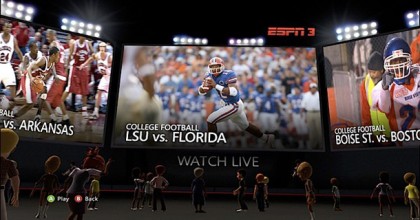
Online Video Streamer
In the more traditional (if we can call it that) digital media device category, top honors once again go to Roku. It’s the little box that could. Featuring perhaps the broadest array of online streaming options. Although you may only care about the biggies like Netflix, Pandora, Amazon VOD, Hulu Plus, YouTube, and NHL. If local media playback is your priority, Roku is the wrong solution. But for everyone else the inexpensive Roku seems like a no brainer for at least one room/television. Roku refreshed their lineup in 2010 and most folks would be best served by the middle unit ($80), which includes the new, more fully functional remote and 802.11n over the lower end unit ($60). Given the current state of USB video playback, you can probably skip the $100 model… unless you intend to share your Flip video on the HDTV. (Roku’s offering free shipping through the 5th if you’re ready to join in or pick up a second.)
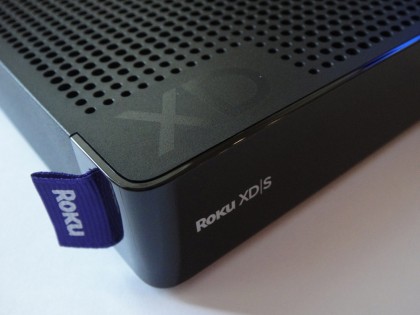
Local Media Playback
For a budget device with solid local playback capabilities, I’m still fond of the WDTV Live Plus ($130). And, not only will it play your rips, it pipes in the likes of Netflix, YouTube, and Pandora. But, if you’ve got a little more money to spend and are willing to take a flyer, the D-Link Boxee Box ($200) is worth a look. I’ve got a lot of confidence in Avner and the rest of the Boxee team to carefully walk that line to meet our needs while appeasing the studios. Of course, at Boxee’s price point, you’re getting close to a more flexible and powerful small form factor computer. But along with those additional capabilities comes additional complexity.
The Future
In addition to the Boxee Box, the new Apple TV ($99) seems to have a decent amount of potential. If they manage to expand and smooth out AirPlay functionality. More importantly for the platform, it seems like an app store is a no brainer and would blow up the market. However, it doesn’t yet exist and Apple may stay the course with curated services like Netflix and YouTube.
Google TV products ($300 and up) are also new this year, and like Apple, the first iteration lacks a marketplace which — limiting its potential. Also limiting is the studio website blockade – truly unfortunate as Google TV brings the very best browser experience to the television (even if this is an intermediate need). While I enjoy Google TV and discover something new just about every time I use it, I can only recommend it to the geeky with plenty of disposable income. At its current price point and level of polish, it’s just not ready for the typical consumer. But, assuming Google (and partners) stick with it, there’s some serious long-term potential here. And hopefully I’ll find the time and motivation to blog it separately.
Lastly, the new TiVo Premiere (now zero dollars, up front!) could eliminate the need for many of these boxes if they get around to modernizing and adding to their selection of third party apps (like Netflix and YouTube). TiVo’s obvious and primary advantage is that it’s a “first input” device that integrates digital cable tuning and recording. So, provide more content and a more sprightly (HD) app interface, and folks may choose to entirely bypass “second input” devices.
Audio
On the connected audio front, like 2009, we still recommend the Sonos S5 ($400). It’s not the cheapest solution by a long shot, but it’s the most elegant. In fact, as I trade our two bedroom temporary housing for a five bedroom house next week, I’m contemplating the purchase of two additional units. I’m still bummed I can’t pipe Slacker or XM through Sonos, but their new iPhone dock is a reasonable stop-gap solution. However, I expect the dynamics to change shortly as Apple AirPlay-compatible speaker systems (like this iHome iW1 unit) hit the market. Which is why Sonos needs to fast track an Android controller… and maybe a home theater system, too.
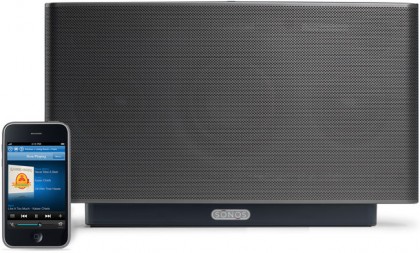
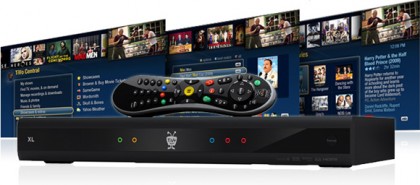
It’s also worth mentioning that connected Blu-ray players have come way down in price this year. Unlike last year, where I had a favorite – there are many strong contenders at various price points with more having online services and all have improved their boot and loads times. I’m still bitter about the many issues related to the 2009 Samsung lineup, so would say in 2010 take a look at the LG or Sony models.
Of course it goes without saying, your perfect box will depend on what you’re trying to accomplish. There really isn’t a one size fits all solution at the moment. It’ll also be interesting to see how cable and satellite DVRs gain capabilities in the next 18 months – Verizon’s probably leading the pack with Internet content and several providers offer nice whole-home streaming and management that exceed TiVo functionality.
(Too bad we haven’t heard anything from Arris/Moxi in some time – their latest retail DVR was off to a great start… and then radio silence. I wouldn’t bank on continued development and therefore can no longer recommend despite their nice streaming/extenders.)
Although I imagine they will be, any Apple AirPlay-compatible speaker systems will also need to be air-tunes compatible. Since airplay from a device can (for now at least) only go to one other device, but from itunes on my computer, I can already pipe to multiple devices.
I’m looking forward to those Iw1s, I hope the price is reasonable, as I could see getting those for multiple rooms.
The Roku is supposed to allow streaming from a usb later this year. And there is a streaming channel out there. Do you not recommend it becuase the quality or ease of use is not there?
It seems to do a lot and the built in wireless helps too. The WD live with a wireless adapter is significantly more than the XDS.
Any comments?
Fred, the two Roku models with a USB slot do currently enable media playback. However, I’d say it’s has very limited codec/container/file options compared to many of the other boxes out there and there’s no smart organization. The existing channels, you refer to, like Roksbox, can be clever but I find them limited and kludgy. From what I’ve read, the Roku hardware should be capable of additional codecs and whatnot if they chose to build support – but if local media playback is a priority, I’d look elsewhere for the moment.
PS The WDTV Live Plus is about $100 at Amazon right now – I’ve seen it as low as $80 I think and as high as $140. But, you’re right – no integrated WiFi. Roku’s a heck of a bargain…
I’ve nominate two boxes. The TiVo HD and the Mac Mini. Slightly pricey at the outset. But considering that they’re boxes from 2008/2009 vintage and still nicely handle all the lean-back tasks I could possibly want as we head into 2011, which means I don’t need to spend on new boxes, they actually become pretty cheap.
Chucky, I had actually intended to go back and edit my first comment to mention your two-box solution. Ha. You should write it up for us to run as a post, as it’s a good one. I saw a Dell Zino on sale yesterday for about $375 – including a Blu-ray drive. Was very tempted… especially knowing we’re getting closer to the three tuner CableCARD HDHomeRun.
How is Netflix streaming on the TiVo Premiere compared to the TiVo HD? I have an HD side-by-side with my PS3, and Netflix streaming on the PS3 is far superior to the TiVo HD.
Dave, both the Premiere and HD use the same app. And it’s probably my least favorite streaming Netflix experience. I haven’t done a side by side to see which drops more – the Premiere has significantly improved throughput/networking, but I’m not sure if the drops on my HD & S3 were related to the implementation or the network bottleneck. Regardless, I NEVER use it and usually go for the Xbox or Roku when I want to stream Netflix. They’re more powerful, faster, and I have none of the TiVo buffering/freezing issues while streaming video.
Chucky, please follow through with the post as Dave suggests. I’m interested for one in diving in a bit deeper to your setup. Thanks.
Roku is claiming ability to use the USB by 12/31? I am assuming it would be fairly standard formats to play back. Am I missing something?
The channel they’re probably going to promote is already live as a private channel:
http://forums.roku.com/viewtopic.php?f=28&t=29367#p182197
Basically, the hooks were opened in the SDK and prolific Roku developer “nowhereman” built a channel to pull the content. Since it first launched, he was hired by the company. And, as I say, I suspect his channel is being polished and perhaps expanded to become the “official” USB support.
Right now the Roku software supports MP3 and MP4 (plus jpeg and png). Not sure how broad that MP4 is.
Nice article Dave, though given how many devices you ended up listing, I’m not sure the title “boxes of the year” is really appropriate. For the people who want a game console, buy the PS3 or XBox 360. Period. If you don’t want one of those, buy a Roku UNLESS you either rip all your DVDs/Blu-Rays to your computer OR you download a lot of stuff off Bittorrent, in which case get a Boxee Box.
All the stuff that should/might be coming in the future–apps and broader AirPlay support on the Apple TV, apps and UI improvements on the Google TV boxes (assuming it survives), Hulu Plus on the Boxee box, I would WAIT for. Don’t buy it until the capabilities show up. You never know what might happen.
Good list, Dave. I generally agree with everything, but — like Glenn said above me — I’d not buy anything based on future potential. In particular, I’m talking about ATV (needs apps/jailbreak/Plex for better codec support), BoxeeBox (wait for VuduHD,Netflix,Hulu Plus, and early bug & UI fixes), and — especially — GoogleTV (there’s really no reason to use it unless, perhaps, if you’re a Dish customer). AirPlay technology is also very raw at the moment.
P.S. Correct me if I’m wrong, but PS3 is the only device that has 5.1 sound on Netflix (DD5.1, I think), so it could be an edge in a non-WMC/U-Verse households that don’t need ESPN3. Although, at this point in time, I feel that many people probably have both, especially with various deal going on.
Glenn, In my mind I had three boxes of the year (360, Roku XD, Sonos S5) and then offered up some alternatives (like the PS3 or WDTV Live Plus) and a few to keep an eye on (TiVo, Boxee, AppleTV).
The thing is, as I wrote in a previous comment, there is no one box that best meets everyone’s needs. And our crowd here is unique in that many of us will sport multiple boxes (for multiple reasons).
I generally agree with Glenn and Ivan not to make purchases based on future potential. Many of us early adopters have learned that the hard way… However, I do think Boxee will get the Vudu and Netflix apps inshort order and the fixes are already rolling. Regarding Apple TV, I need to give that iPhone jailbreak AirPlay-anywhere app/functionality a whirl.
Ivan, the PS3 is first with Netflix surround… but surely there will be others. From their release:
Beginning October 18, the PlayStation®3 (PS3™) computer entertainment system from Sony Computer Entertainment, Inc. will be the first consumer electronics device to support 5.1-channel surround sound on movies streamed from Netflix. Netflix said more devices would be added over time to support streaming digital surround sound.
Unfortunately, no one box provides a great UI, Internet streaming, local streaming, access to all the must have apps/channels, etc., so ‘Boxes’ of the Year is probably the best approach at this point.
In my main viewing area I use a Roku XD|S, PS3 and Apple TV. While I love my Rokus (four throughout the house), I find myself using the PS3 more lately. The recent inclusions of Hulu Plus and Vudu, disc-less Netflix and a great UI make it my preferred device right now.
It will be interesting to see if Apple brings apps to the Apple TV and adds polish to AirPlay; and if Roku makes improvements to local playback capabilities and the UI. While there have been noted improvements (i.e. the Netflix channel, the Channel Store and the banner graphics), the overall appearance and feel of the UI is still significantly inferior to that of the PS3 and Apple TV; and from the looks of it (I don’t have personal experience), the Boxee box.
Good writeup Dave,
I would say with the recent update to the Boxee Box it now moves up to my top box as it now plays my Bluray ISO rips flawlessly, and all of the streaming I watch (TWIT.TV and Revision3) play great at well.
The browser needs some work still, but its a much better box then it was just a few weeks ago.
I would say the biggest diapointment in a box I have had is with GoogleTV. It’s the 2010 version of WebTV and it does not do much of anything good.
While I believe it can be a good box and the hardware is solid the current software shows me they rushed it out in time for the Holiday sales, but the software has a long way to goto make it usable and enjoyable.
I have done a lot of hardware reviews over the years and the GoogleTV was the first one I got where I didn’t even want to review it once I used it because it was hard to find good things to say about it.
I expect the entire IPTV landscape to be a much different landscape this time next year.
@Scott et al,
Yup. Things seem likely to change radically by the end of the first quarter of 2011 even.
Apple TV:
I would expect some improvements to Air Play (extensions to 3rd party apps at least, and support for shot on iPhone video). Maybe an announcement about app support.
Google TV:
Hopefully some serious updates. We know the app market is coming, so maybe with it some apps like Hulu Plus and Amazon. Also they need to integrate search into more of these sources along with better video search in general. Presumably some pricing adjustments as well.
Boxee Box:
Significant updates need to be coming by this point. Hulu Plus and Netflix at least.
From the Pay TV companies it looks like remote viewing of on demand content (on your iPad especially) is the next competitive frontier so that area should be adequately covered (though I’ll still want all my STBs to be sling enabled). Internet to the TV will likely still be in transition though.
I’m a heavy TiVo HD netflix user, and while it sucks that I can’t use it to add things to my queue, I’ve only ever had the actual thing fail once, and even that was just a 10 second pause. I’ve probably watched over 100 hours of streaming, and had one glitch. Maybe I’m just lucky, but it seems like a pretty solid implementation to me.
I also use pyTivo to watch content I DL from the net to my tivos. (stream baby sometimes, but it takes longer to get though the menus for that).
And I can move content from one tivo HD to the other (99% of the time in faster than real time), so mutli room viewing is awesome. I don’t play console games, so basically the Tivo HD does everything I could need.
That being said, maybe I just don’t know what I’m missing, as I don’t have a Roku, boxy, ps3 or xbox.
(I do have sling solo hook up to one of my tivos, and I do use air-tunes to stream my music around the house).
Your streaming Netflix experience on TiVo sounds much better than mine. But even if it worked reliably, I’d prefer to browse the entire catalog and playback content with or without adding to the queue. And it still needs to be faster.
MRV doesn’t work for me as long as I’m on Cox. They’ve really locked down the content with their CCI Byte level. One day I’ll probably move to FiOS, but I’m not ready to mess with it at the moment. Let’s put it on the calendar for Q1 ’11.
I do enjoy Amazon HD VOD via TiVo on occasion when I have time to wait for the download. Amazon content is fully downloaded on TiVo versus streaming on Roku.
New google TV update, YES they LISTENED TO ME!!!
Downloading it now.
I have a Tivo Series3. What I need is a media streaming box that supports something like kmttg/pytivo etc. I’d just like to content on the Tivo streamed to a tv in another room. Suggestions? Doess a wdtv have enough space/power to support streaming and decoding? Thanks.